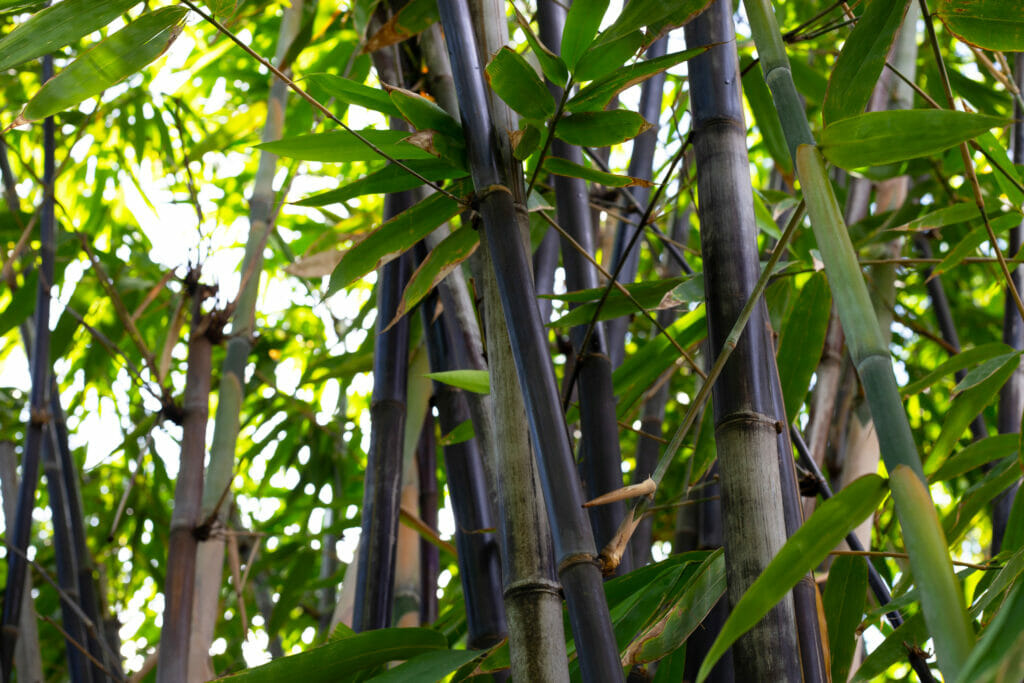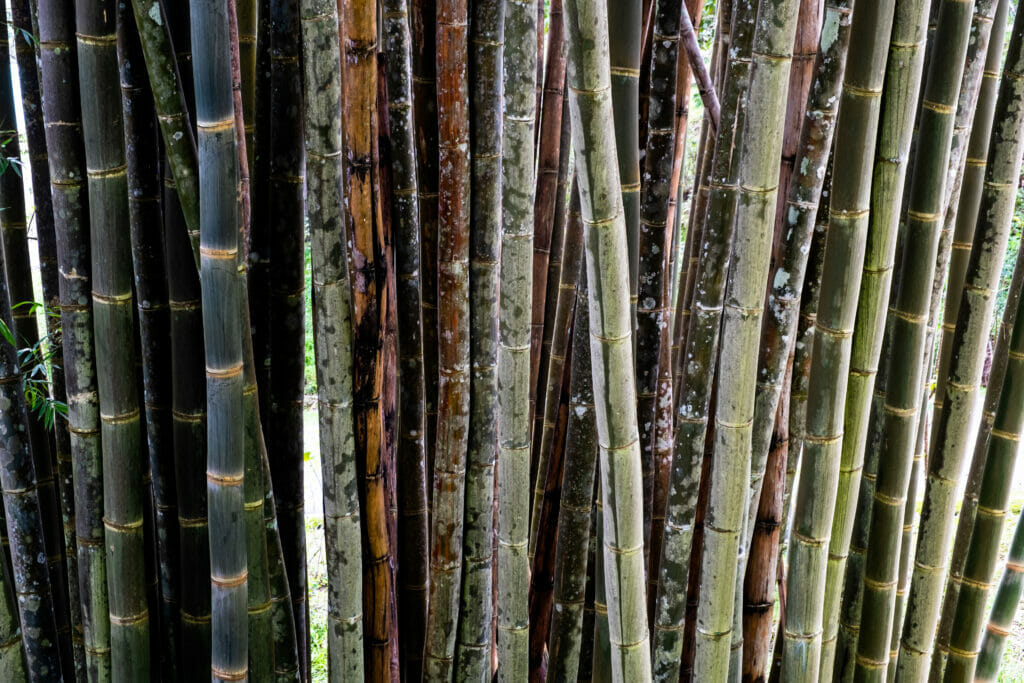Also known by the Latin name Phyllostachys nigra, black bamboo has in recent years become a sought after plant for modern UK garden design. This tall, running bamboo variety, sometimes referred to as purple bamboo, is an evergreen plant with an eye-catching aesthetic. Its fluttery leaves and tall, arching growth can be cut to form a canopy and create a calming space in which to relax. However, it has also gained the reputation of a bamboo variety that is extremely fast growing, and a potential cause for concern. There is ambiguity in online information as to whether Phyllostachys nigra (black bamboo) is one of non running bamboo plants, or a runner that could quickly spread across your garden.
This blog article aims to bring some clarity to the situation and answer some of the key questions posed about black bamboo and running bamboo varieties.
What does black bamboo look like?
Black bamboo gets its name from the dark colour of its culms (stems), which can range from dark green to black. These create a striking effect against its green foliage. The Phyllostachys nigra canes have a smooth texture and are usually quite slender; they develop darker colouring and a glossy sheen as the plant matures. Known for its impressive height, black bamboo’s fast growth rate is also a clue that it has the potential to spread.

Phyllostachys nigra, Black bamboo canes at various stages of maturity iStock.com/Bowonpat Sakaew
Characteristics outside of its native habitat
Phyllostachys nigra, black bamboo, is native to China but has become a popular plant in UK garden centres. Given conditions different to those of its native habitat, black bamboo and its sub species can exhibit different growing characteristics. Part of the reason there is confusion about whether to classify the plant as running bamboo or a clumping variety, is that in the UK it can exhibit characteristics of both. Whilst defined ‘a running bamboo’, in the colder climate of the UK and whilst the plant is establishing itself, black bamboo can remain relatively confined to the area it was planted.
Initially, whilst still fast growing, black bamboo will remain in a clump much like other non-running bamboo plants. However, over time, once established and sometimes after several years, it can start to display its inherent growth habit – that of running bamboo. If this happens, lateral bamboo rhizomes will extend from the bamboo stand and send runners across your garden and potentially into that of your neighbours.
Types of black bamboo
Whilst it’s Phyllostachys nigra that has earned the common name ‘black bamboo’, somewhat confusingly there are other species of bamboo that have varieties with black culms (or canes):
| Species | Growth Habit |
| Dendrocalamus brandisii | Running |
| Bambusa lako | Clump forming |
| Gigantochloa atroviolacea | Running |
| Otatea acuminata aztecorum | Clump forming |

Close-up of Dendrocalamus brandisii (Munro) Kurz., or Burma bamboo. Giant bamboo trees green background iStock.com/rivermartin
And, to add to the confusion, some members of Phyllostachys nigra family don’t have black or completely black canes (or culms):
| Variety Name | Colour/Patterning |
| Phyllostachys nigra ‘Henonis’ | Green with brown or black stripes |
| Phyllostachys nigra ‘Megurochiku’ | Black |
| Phyllostachys nigra ‘Punctata’ | Green with black spots |
| Phyllostachys nigra ‘Boryana’ | Green with brown or black markings |
| Phyllostachys nigra ‘Black Prince’ | Green with black culm sheaths |
What’s the difference between running and clumping bamboo?
Running bamboo has a more aggressive growth habit when compared to clumping bamboo. Species of clumping bamboo form tight groups of culms (clumps), with rhizomes that don’t spread in the same manner as those of running bamboo.
Some species, black bamboo included, can exhibit both clumping and running habits, depending on the conditions the plant is growing in. Black bamboo may remain clump-forming in poor or dry soils but can become invasive in warm, moist favourable conditions. As such, it is important to consider this when adding black bamboo to a garden or taking on a garden where it has been planted for ornamental or screening purposes.
How to identify running bamboo?
Identifying running bamboo can be determined by looking for certain growth characteristics, and observing the bamboo plant’s behaviour over time. Here are 5 key points to help with identification:
- Rhizome growth & structure:
Running bamboo varieties have extensive rhizome systems that send out horizontal underground stems. These are visible when digging around the base of the bamboo plant. - Shoot emergence:
The rhizomes, that lie just beneath the surface soil, will give rise to new shoots which can be far from the original plant. These can emerge in flower beds, between paving slabs and in neighbouring properties. - Distance between culms:
The distance between established bamboo stands will be larger compered to clumping varieties. - Growth rate:
Running bamboo tends to grow more quickly and aggressively than non-running (clumping) varieties. - Spread over time:
Whilst in the UK some varieties might not spread initially, then the bamboo stand can gradually extend its reach by sending up shoots further and further from the original plant.
How tall does running bamboo grow?
Running bamboo can grow up to 30 feet (9 metres) tall. Black bamboo culms grow in dense clumps, creating a beautiful and dramatic effect in the garden, which is why the plant is known for its impressive height, many reaching up to 20 feet (6 metres). Grown in a container however, black bamboo often won’t top 15 feet (4.5m).
Should you remove running bamboo?
Bamboos can be a good ornamental plant; however, there are a few problems that can be encountered when planting them directly in a garden.
- Running bamboo shoots may pop up anywhere, including in gaps between solid barriers such as patios, conservatory floors or decking.
- Most weed suppressant fabric will not stop running bamboo from spreading. Something more specialist will be needed.
- Running bamboos grow very large, very quickly and can create too much shade in a small garden.
Removing running bamboo rhizome can help control its spread throughout a garden. However, once the plant has started spreading, it will be the start of an on-going battle. In cases where there is no barrier in place, the removal of running bamboo will require digging out the rhizomes and the culms growing from them.
When large stands of bamboo, or culms in heavy soil are involved, this can be a very labour intensive task. To remove running bamboo manually it is best to use a sharp spade to dig up the entire clump, or to remove sections at a time. Sever the rhizomes as you go, lifting and removing them with a fork.
Practically, to control the spread of black or running bamboo, a root barrier will be required. A specialist bamboo barrier is recommended to ensure that the solution put in place isn’t penetrated. If this is not possible, removing running bamboo rhizomes will be an essential to ensure the plant remains aesthetic but controlled in your garden.
Does clumping bamboo need a barrier?
Whilst clumping bamboo species are less aggressive in their lateral growth, non-running bamboo plants still possess the potential to expand their root system over time. As previously noted, black bamboo is an example of a running bamboo that doesn’t typically exhibit invasive properties in the UK climate, or at least initially. However, over time and once established it can start to send out bamboo rhizome runners to establish new stands. Black bamboo is one example, but is not unique in displaying differing, or delayed characteristics outside of its native habitat.
Even bamboo that remains clump forming can be a problem in the wrong location; exerting pressure on fences or structures, and creating issues around services. By installing a bamboo barrier, gardeners and landscapers can safeguard against the spread of bamboo rhizomes beyond desired boundaries. This helps to ensure that the garden landscape remains organised and minimises the risk of encroachment into neighbouring properties.
If you are concerned about removing running bamboo at your property, or that Phyllostachys nigra (black bamboo) is starting to spread, speak to a member of our team. Call 0203 174 2187 or 01202 816134 and we can advise on solutions that involve removal, or the installation of a bamboo barrier for containment.

